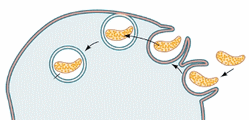Active Transport
Active transport is a biological process that moves molecules across a cell membrane against their concentration gradient, from an area of lower concentration to an area of higher concentration. This movement requires energy, usually in the form of adenosine triphosphate (ATP).
Molecular Transport
Protein Pumps
Proteins in the cell membrane use energy (ATP) to move materials into and out of the cell.
The sodium-potassium pump moves sodium ions (Na+) out of the cell and potassium ions (K+) into the cell against their concentration gradients.
Bulk Transport
Endocytosis
Membrane folds around a particle and forms a vesicle within the cell.
Phagocytosis - engulfing of large particles, usually for food. White blood cells use this method to destroy invading bacteria or remove damaged cells.
Pinocytosis - engulfing of liquid particles
An amoeba (protist) engulfing a smaller protezoan.
Exocytosis
A vesicle within the cell fuses with the cell membrane, contents are then forced outside the cell.
- Secretion of cell products, such as hormones
- Neurotransmitter release in nerve cells
- Cell waste removal
- Cell growth and repair (new membrane components are added to the cell membrane)
Practice Questions
1. What is the main difference between active and passive transport?
2. How is active transport used by the immune system?
3. What are the two types of active transport?
4. What would happen if the sodium potassium pump stopped functioning?
5. The cystic fibrosis transmembrane protein (CFTR) plays a critical role in regulating the movement of chloride ions across the cell membrane. In individuals with cystic fibrosis, chloride ions build up within the cell. What affect would this have on intracellular and extracellular fluid?




